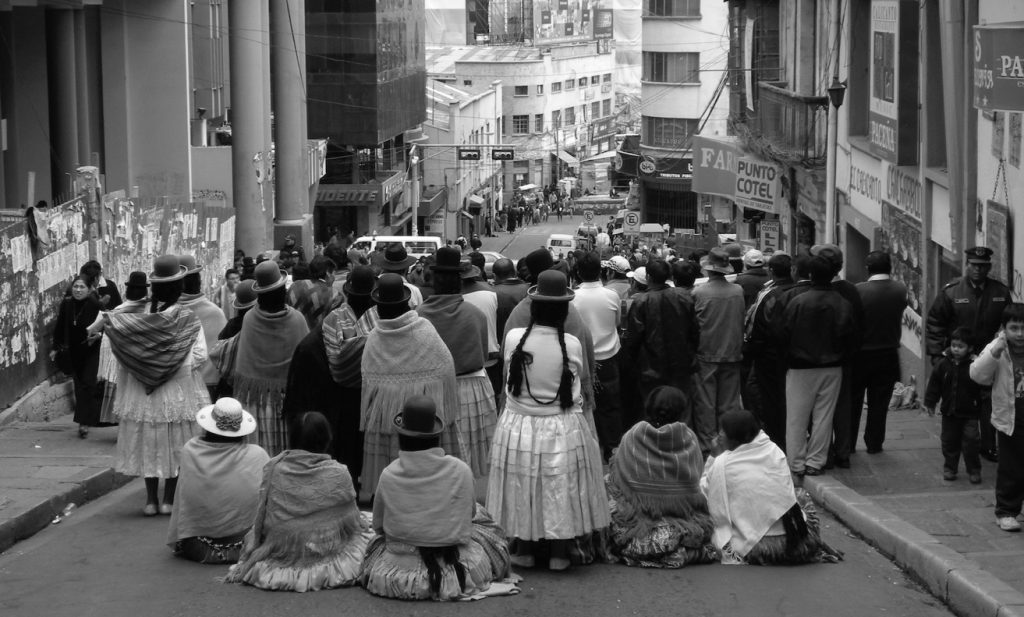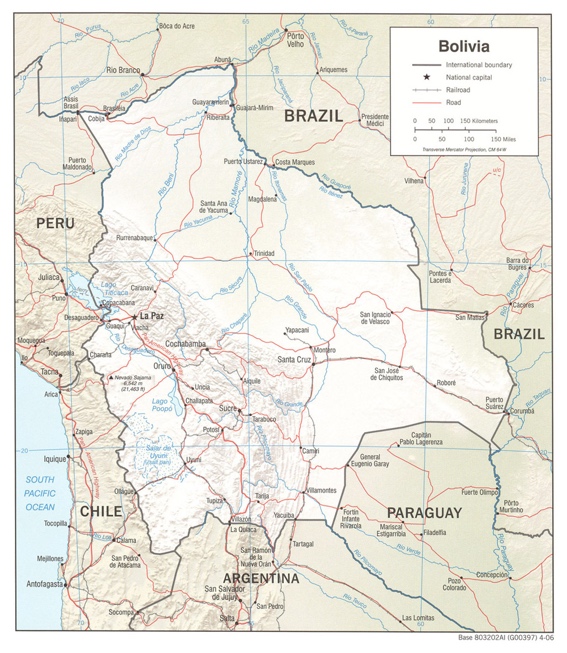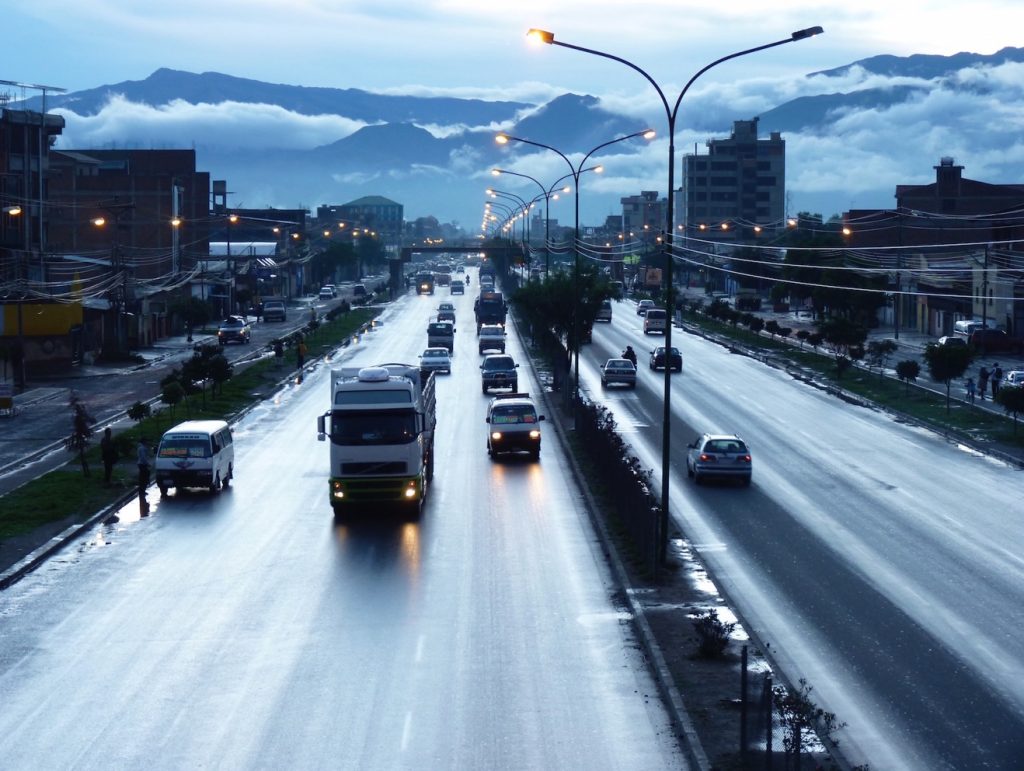On June 23, 2008, three of us ascend an eerily empty highway from the tropical town of Coroico to Bolivia’s capital, La Paz. Foreigners, we stare at the majestic valley below as we pass above the line where the tropical tree cover of the Yungas gives way to pure rock. The so-called Death Highway has been rebuilt on a more secure footing, but it is still marked by hairpin turns, intruded upon by fallen boulders of a terrifying scale, and undermined by landslides. Its predecessor, once calculated as the world’s deadliest roadway, has been preserved as a downhill biking path for tourists seeking “100 percent adrenaline.” Where the road has fallen or washed out, drivers let their wheels dig tracks into the mud and gravel tracks, and peer over the edges of their vehicles to avoid falling off the side.
Today, however, both roads are nearly silent. None of the half dozen minibus unions are operating their vehicles, bike tours are cancelled, and the taxi we found cruises over empty roads and easily steers clear of both the rock faces and the treacherous edges. Once finally inside La Paz however, it comes to a stop at the cause of all the earlier silence: an urban road blockade. Residents of the northeastern District 13, organized through 46 neighborhood councils, have plugged the main arteries through their neighborhood with stones and their collective presence. They are calling on the municipality to meet an eight-point platform of demands concerning crime, public works, and water provision. Taxis like ours can approach the protest zone but only to discharge their passengers. Dozens of men and women walk—their goods stacked on their heads, bundled in fabric on their backs, or dragged along in suitcases—across the vehicle-free stretch of urban pavement, littered with stones and occupied by protesters who gather in the middle.
Every point along the road we have travelled is a potential chokepoint. Since the main road from La Paz to the Yungas passes through this district, a single blockade is enough to cut off all traffic to Coroico, the Yungas, Caranavi, and the northern Bolivian Amazon. Whether accomplished by simply sitting down in the street, dragging in boulders and tree limbs, or coordinating crowds of thousands to take over key thoroughfares, road blockades bring a sudden urgency to political protest. By blocking the circulation of people and goods, they ensure that the impacts of protest ripple across an entire region.
A Land of Blockades
Landlocked Bolivia sits astride the Andean mountains, the middle of a continent that is a global hotspot for road blockades as a form of protest. In 2004 and 2008 Latin American Public Opinion Project surveys, around a third of Bolivians reported they had participated in a protest in the past twelve months; in less active years, the number hovers around one in seven. Monitors at the Center for Studies of the Economic and Social Reality (CERES) counted around fifty rural road blockades and forty urban blockades each year from 2000 to 2007. Evo Morales, the country’s first indigenous president, was elected in 2005 after waves of protests using blockades caused two presidents to resign in 2003. To the surprise of many, protests increased in frequency in later years, as disruptive protest became an important form of political participation.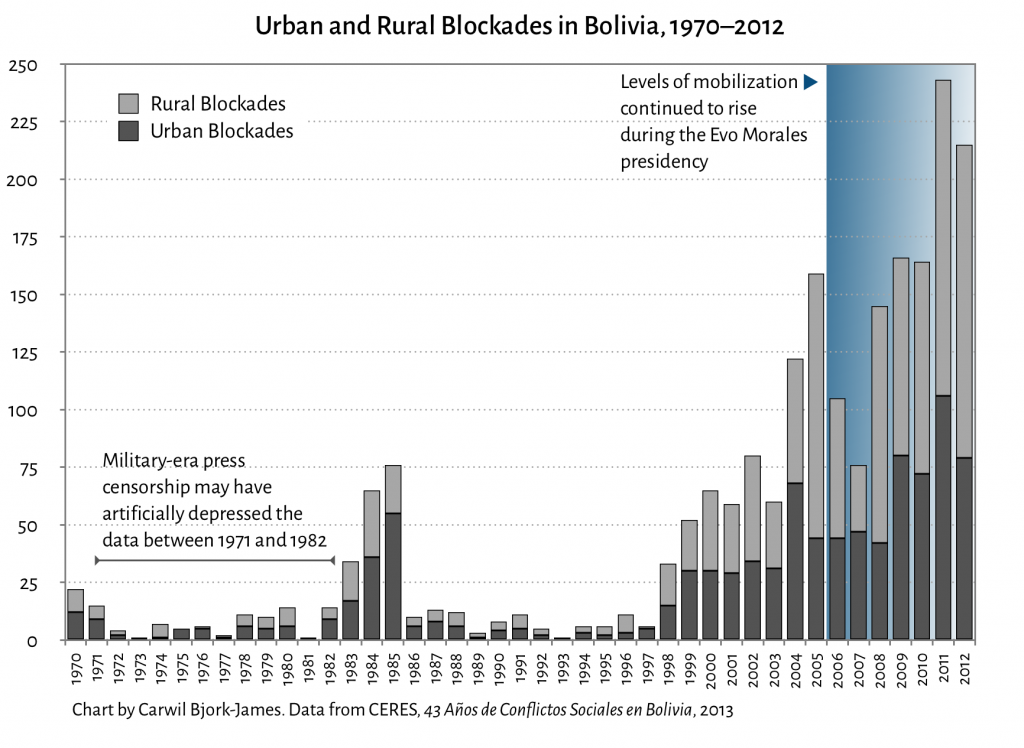
Most of the country’s 11 million people live in one of the nine provincial capitals or adjacent cities. The high plateau called the Altiplano once housed the vast majority of Bolivians, but cities in the vast lowlands have mushroomed in recent decades, spreading out the population over a country the size of California and Texas combined. The Altiplano roads are narrow tracks in a vast deserted plain, the northeastern Amazonian lowlands are plagued by washouts in the rainy season, and narrow winding roads span the rugged Valleys in between. Until the doble vía opened between La Paz and Oruro in 2011, no intercity route was wider than one lane in each direction. Less than one kilometer in nine of those roads is paved. With so little road connecting so much territory, Bolivia is rife with extant—and potential—chokepoints. Enter the blockade.
Given this, the ability of a single La Paz district to cut off the city by land from the northern lowlands is far from exceptional. All of the country’s highways integrate into the regular street grid upon their entrance into the cities. For example, Cochabamba’s western highway connecting to La Paz, Oruro, and Potosí becomes the wide Blanco Galindo Avenue as it arrives in Quillacollo. When it’s shut down, there is no alternate route for large truck and bus traffic. As a result, dedicated blockaders in Quillacollo or Colcapirhua can isolate the metropolis from the western third of the country. Blockades at two more chokepoints would be sufficient to isolate Cochabamba from the rest of Bolivia, cutting the paved portion of the national road network in half in the process.
That is just what happened when urban and rural Cochabambans collaborated to reverse the privatization of their municipal water company in a campaign that became known as the Water War. The first rumbles of that protest occurred outside the city, led by the Departmental Federation of Irrigation Farmers (called the Regantes). In November 1999, they blockaded the highways from Cochabamba to Oruro, the Chapare, and the Valle Alto. Using “tree trunks, branches, tires, stones, and vehicles,” residents set up over twenty blockades from the midpoint of Blanco Galindo west to the small town of Parotani, an hour’s drive away. Urban residents studied these tactics and replicated them in future waves of mobilization.
In January, urban and rural communities coordinated their efforts in the first of several regionwide blockades. Unions took charge of six bridges across the Rocha River into downtown Cochabamba, the Regantes maintained control of rural highways, and a new force emerged on the urban outskirts: neighborhood water committees. These organizations had been founded to do the logistical work of supplying water where the utility company didn’t go: digging wells, managing cisterns, and sharing the costs and labor of laying water pipes. But, like the peasant unions outside the city, their assemblies proved useful for organizing a different kind of labor: mass participation in protest.
Activists held an unauthorized urban referendum in the streets on March 26; more than fifty thousand people cast paper ballots rejecting the privatization contract. A week later, the movement launched a general blockade of the city and the region. A communiqué was sent out: “Supply yourselves with food, water, medicine, lanterns, radios, and all that will be necessary in accordance with the experiences of past struggles.” Blockade committees met in all parts of the metropolis to prepare a total shutdown.
While a single blockade can shut down a major transport route, a carefully orchestrated constellation of blockades can shift the feel of urban space radically. Marcelo Rojas, one of the protest participants I interviewed in 2010 and 2011, remembers how a net of blockading crews carpeted the central city. “We began to create other groups on each corner”—his hands create a virtual map on the desk between us, working outwards from the central plaza. “We began to surround it, to make circles, as far as Aroma [Street] and the stadium. It was all these groups of people, and to enter the plaza you had to pass as many as ten groups.” What impressed Marcela Olivera was the desire to blockade absolutely everywhere: “For example, Quillacollo, on that avenue—I don’t know if you’ve been to Urkupiña”—a massive religious festival that takes place every August 15. (I have been to it. That avenue floods with more than 200,000 dancers, pilgrims, and visitors honoring the Virgin Mary.) She continued, “That avenue was blockaded. Who wants to go to [the] Calvario [sanctuary] then, right? But there wasn’t anything else to blockade, and so the people had blockaded that.” The blockaded zone continued westward through Quillacollo, east through Sacaba, and throughout Cochabamba’s Zona Sur. With broad enough participation extending across wide enough space, the blockade ceases to be something done by a mobilized few to the rest of the region, and “the entire city,” “department,” or “country” becomes part of the strike.
Major blockades don’t just hit the pocketbooks of businessmen. More urgently, they hit the population through their stomachs. To explain the impact of the Water War, Christian Mamani started with vegetables: “We’re talking about potatoes, ocas, all kinds of tubers, and even some … even corn and choclo.” Food becomes the language through which economic pressure is exerted, felt, and remembered. “Even we ourselves felt this means of pressure,” he continued, “And some neighbors needed to buy some vegetables, and so we loaned vegetables from one of us to the next, and we went to find the [rural] unions and see if someone might be able to sell us an onion, a tomato. And this is how we kept up this means of pressure, which was quite harsh.”
The pressure worked, spectacularly. The national government not only rolled back the water privatization but also repealed the law designed to enable it. This victory, and the success of a simultaneous rural blockade on the Altiplano, opened the floodgates to hundreds of actions that followed.
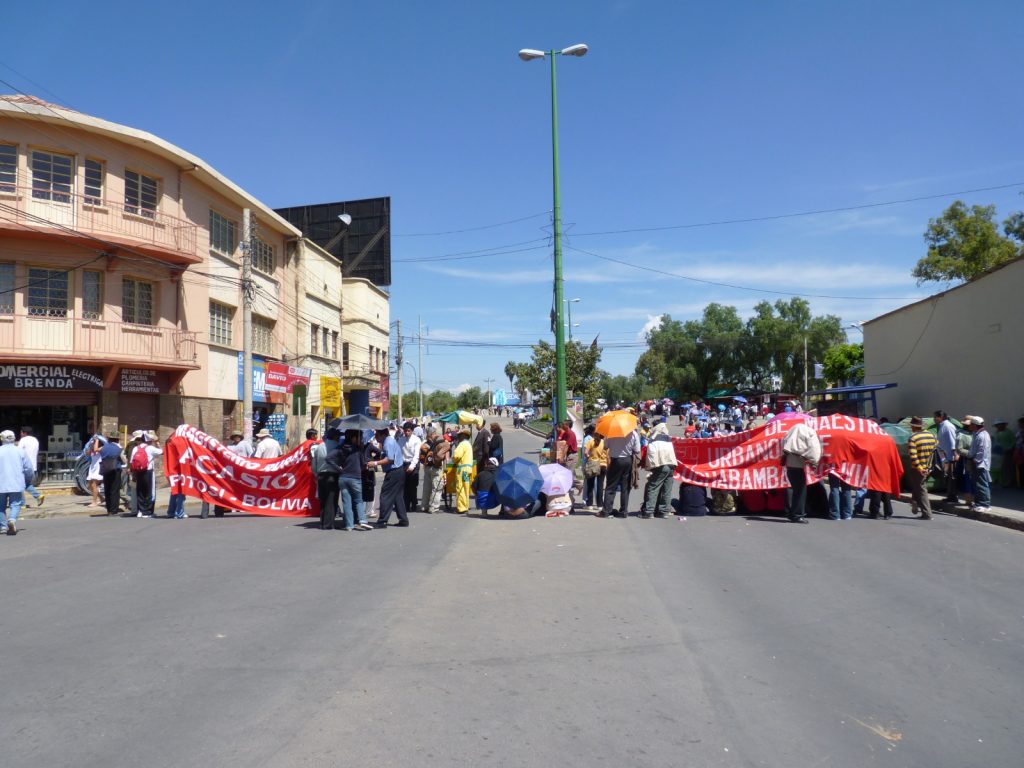
Rural and Urban Teachers’ Unions divide the work of blocking Heroínas Avenue near downtown Cochabamba in April 2011. C. Bjork-James
From local protest to a national uprising
In September and October 2000, highland peasants’ unions, striking teachers’ unions, and coca growers synchronized their protests into a national blockade campaign focused on the capital of La Paz, which sits in a topographic bowl just off the side of the overwhelmingly indigenous plateau called the Altiplano. As the blockade extended into its third week, food grew scarce in both working-class and elite neighborhoods; unexpectedly, though, the burden fell harder on wealthier neighborhoods. Middle-class Bolivians are accustomed to shopping in supermarkets and buying refrigerated goods every few days. Urban indigenous residents, on the other hand, relied on a different set of commodities in daily life. The tubers Mamani spoke of, as well as chuño (a freeze-dried potato), pasta, and quinoa are goods traded in large quantities and stored for slow and steady use. When the government tried to airlift in food, using the airport in La Paz’s overwhelmingly-Aymara twin city El Alto, housewives blockaded the shipments and demanded the government negotiate. In the end, the government was forced to sign agreements with the blockaders.
In 2003, movements across Bolivia began coordinated campaigns to renationalize the country’s gas resources, support small farmers, and rewrite the constitution. Grocery store shelves emptied again in La Paz, and gasoline grew scarce. President Gonzalo Sánchez de Lozada’s government banned blockades and sent in the army to break them up and escort fuel tankers through. But when protesters were killed—a five in September and more than 60 in October—protesters only intensified their blockades, supplementing them with hunger strikes and the largest march Bolivia had ever seen. Deserted by his allies, Sánchez de Lozada resigned and fled to Miami. Congress repealed the law criminalizing blockades, and Bolivia’s 2009 constitution promises strong protections for the right to strike.
Blockades as everyday forms of protest
On April 14, 2011, I sit with two striking teachers tending a barricade made of a few logs stretched across a street along Cochabamba’s Rocha River. It is one of hundreds set up across Cochabamba at the crest of a national strike wave of public workers. On a normal school day, the 13-kilometer journey from their homes in Quillacollo is a struggle with bus transfers and long walks with their children in tow. But today there are blockades up and down Blanco Galindo Avenue complicating everything. “We were victims of our own struggle,” they both say, laughing. “We suffer a lot with all this, strikes and blockades and all those things,” Lubia Vargas Padilla tells me, but it works. “The only way that they listen to us is this, because we have no other way of saying no. … If we don’t use a coercive method, we achieve nothing.”
It is Bolivians themselves who give one another the right to strike. The men and women who drive the Highway of Death could have broken through the neighbors’ line, but chose not to; like most Bolivians they respect the strike. It is precisely when transport unions cancel their scheduled routes, when bus drivers idle their motors on highway, when shopkeepers shutter their doors that a barricade in the streets becomes a building block towards a general strike. People defer to and accept these tactics because on another day, they might carry out a strike of their own. Each small group, from a neighborhood council to a primary-school teaching shift to an outlying neighborhood, can grasp the nearest chokepoint to demand what they need. In Bolivia, the combination of sparse roads and deep solidarity makes big changes possible.
